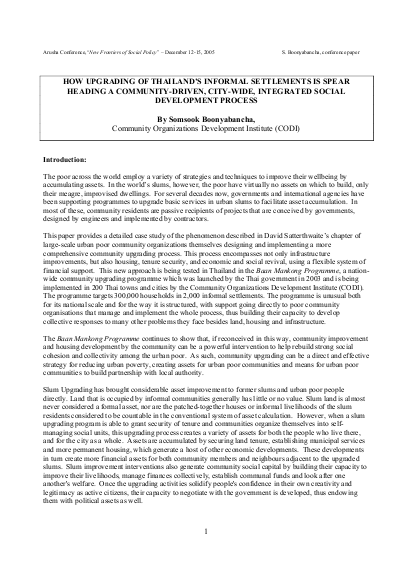
The poor across the world employ a variety of strategies and techniques to improve their wellbeing by accumulating assets. In the world’s slums, however, the poor have virtually no assets on which to build, only their meagre, improvised dwellings. For several decades now, governments and international agencies have been supporting programmes to upgrade basic services in urban slums to facilitate asset accumulation. In most of these, community residents are passive recipients of projects that are conceived by governments, designed by engineers and implemented by contractors.
This paper provides a detailed case study of the phenomenon described in David Satterthwaite’s chapter of large-scale urban poor community organizations themselves designing and implementing a more comprehensive community upgrading process. This process encompasses not only infrastructure improvements, but also housing, tenure security, and economic and social revival, using a flexible system of financial support. This new approach is being tested in Thailand in the Baan Mankong Programme, a nationwide community upgrading programme which was launched by the Thai government in 2003 and is being implemented in 200 Thai towns and cities by the Community Organizations Development Institute (CODI). The programme targets 300,000 households in 2,000 informal settlements. The programme is unusual both for its national scale and for the way it is structured, with support going directly to poor community organisations that manage and implement the whole process, thus building their capacity to develop collective responses to many other problems they face besides land, housing and infrastructure. The Baan Mankong Programme continues to show that, if reconceived in this way, community improvement and housing development by the community can be a powerful intervention to help rebuild strong social cohesion and collectivity among the urban poor. As such, community upgrading can be a direct and effective strategy for reducing urban poverty, creating assets for urban poor communities and means for urban poor communities to build partnership with local authority.
Slum Upgrading has brought considerable asset improvement to former slums and urban poor people directly. Land that is occupied by informal communities generally has little or no value. Slum land is almost never considered a formal asset, nor are the patched-together houses or informal livelihoods of the slum residents considered to be countable in the conventional system of asset calculation. However, when a slum upgrading program is able to grant security of tenure and communities organize themselves into selfmanaging social units, this upgrading process creates a variety of assets for both the people who live there, and for the city as a whole. Assets are accumulated by securing land tenure, establishing municipal services and more permanent housing, which generate a host of other economic developments. These developments in turn create more financial assets for both community members and neighbours adjacent to the upgraded slums. Slum improvement interventions also generate community social capital by building their capacity to improve their livelihoods, manage finances collectively, establish communal funds and look after one another's welfare. Once the upgrading activities solidify people's confidence in their own creativity and legitimacy as active citizens, their capacity to negotiate with the government is developed, thus endowing them with political assets as well.
Resource collections
- Evaluating humanitarian action
- UN Habitat - Urban Response Collection
- Urban Response - Urban Crisis Preparedness and Risk Reduction
- Urban Response Collection - Community Engagement and Social Cohesion
- Urban Response Collection - Economic Recovery
- Urban Response Collection - Environment and Climate Change
- Urban Response Collection - Housing, Land and Property
- Urban Response Collection - Urban Crisis Response, Recovery and Reconstruction
- Urban Response Collection - Urban Resilience